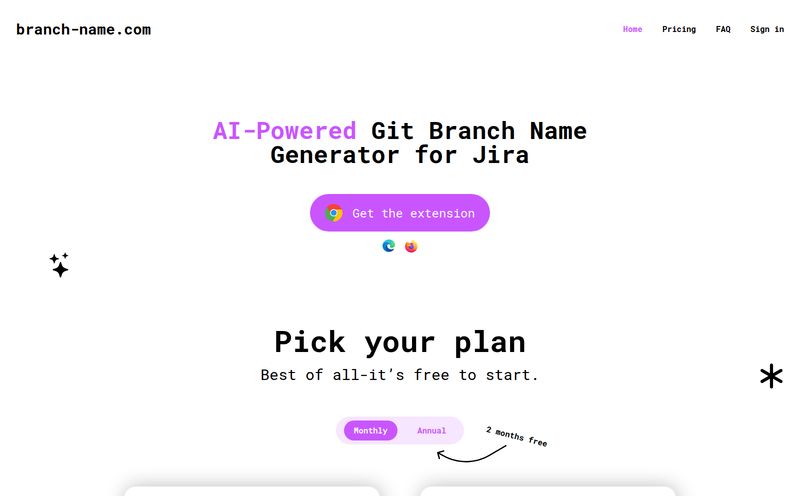You know the feeling. You’re setting up a new desktop, designing a presentation, or just tinkering with your personal website, and you hit a wall. The dreaded background. You spend hours scrolling through Unsplash, Pexels, and every stock photo site under the sun, but everything feels… generic. Soulless, even. You want something unique, something that’s yours, but you don't have the time or the Adobe Illustrator chops to create a complex seamless pattern from scratch.
For a beautiful, brief moment, we had a perfect little solution for this. A tool called TileMaker.
I stumbled upon it a while back, probably through a thread on Hacker News or a late-night GitHub dive. The premise was brilliant in its simplicity: a free, open-source web app that used AI to generate completely unique, seamless tiled images. You type in a prompt, it spits out a pattern. Simple as that. It was one of those tools that did one thing, and it did it surprisingly well. I made a few funky, abstract backgrounds for my phone and kind of forgot about it.
Then, the other day, I thought, “You know, I should write about TileMaker.” It’s the kind of project I love—indie, creative, and genuinely useful. So, I typed in the URL, ready to generate some fresh patterns for this very article, and was greeted by… a 404 error. “This page could not be found.”
Oof. A digital ghost town. And just like that, this article changed. It's no longer just a review; it’s now a bit of an investigation and, I suppose, a tribute.
So, What Exactly Was TileMaker?
For those who missed its short but sweet existence, TileMaker was a minimalist’s dream. It wasn't trying to be Midjourney or Stable Diffusion. There were no complex settings, no learning curve, no Discord servers to join. It was a single webpage with a text box. You’d write something like, “a pattern of tiny, colorful geometric birds” or “Art Deco style brass and marble lines,” and the AI would get to work.
A few moments later, you’d have a tileable image based on your prompt, ready to download as a wallpaper for your computer or phone. It was built for a specific purpose: creating beautiful, repeating backgrounds without any fuss. It was the perfect tool for developers needing a quick placeholder texture, designers looking for a spark of inspiration, or just regular folks like you and me who wanted a cool phone background that no one else had.

Visit TileMaker
It was a prime example of the open-source spirit. Free to use, built with passion, and solving a real, albeit niche, problem.
The Magic Behind the Curtain
I did a little digging into what made TileMaker tick, and its tech stack is a classic 2023/2024 starter pack for an indie AI project. It was built with Next.js and Tailwind for the slick front-end, and hosted on Vercel. The entire project was available on GitHub, which is always a good sign.
But the real engine room, the source of its creative power, was the Replicate cloud API. Specifically, it was using a model called Material Diffusion. Instead of just generating a static image, this model is trained to produce textures that can be tiled seamlessly. This is the secret sauce. Without seamless tiling, you get those ugly, obvious seams when you repeat an image as a background. TileMaker completely solved that.
And this, my friends, is where our story might take a turn. That reliance on an external API is both a blessing and a curse.
The Good, The Bad, and The… Missing?
It’s easy to see what made TileMaker so appealing. It had some serious advantages, especially for a free tool. But it also had limitations that, in hindsight, might have been foreshadowing.
What I Loved About TileMaker
First and foremost, it was free and open source. You can’t beat that. It democratized a small piece of AI creativity. The ease of use was its biggest selling point. If you can type a sentence, you could use TileMaker. This low barrier to entry is something I feel a lot of bigger platforms miss. Not everyone wants to learn prompt engineering and a dozen command-line flags. Sometimes you just want to make a thing. And, of course, the output was genuinely cool—AI-powered wallpapers on demand.
The Potential Downsides
Naturally, it had limited features compared to professional software. You couldn't tweak the resolution, fine-tune the model, or edit the results in-app. It was a one-shot deal. But the bigger issue, the elephant in the room, was its dependence on the Replicate API. Running AI models costs money. APIs have usage limits and monthly bills. For a free, passion-project, those costs can add up fast. The developer was essentially footing the bill for every wallpaper everyone generated. That’s generous, but not always sustainable.
The Curious Case of the 404 Error
So, where did it go? A 404 error on a Vercel-hosted app can mean a few things. The developer could have simply taken the project down. Maybe the API bills from Replicate got too high, or they lost interest and decided to unpublish the site. It’s the silent death that so many brilliant little internet projects face. One day they’re there, the next, a 404 page is all that’s left.
It could also be a temporary issue, a deployment that failed, or a domain that expired. But given that it's been a while, my money is on it being retired. It’s a shame, but also a stark reminder of the fragile nature of the web, especialy the non-commercial parts. These tools we love are often run by one person in their spare time. Life happens. Priorities change.
Where to Go From Here: Finding TileMaker Alternatives
So TileMaker is gone (for now, at least). But the need for unique, seamless patterns remains! Luckily, the AI world moves at a breakneck pace, and there are other options out there.
Here are a few alternatives you can check out:
- Midjourney: If you’re already in the AI art ecosystem, Midjourney has a powerful
--tileparameter. It's a bit more involved and requires a subscription, but the quality is top-notch. You can create incredibly detailed and artistic patterns with it. - Adobe Firefly: Adobe has jumped into the AI game with both feet. Their Firefly suite includes a “Text to Pattern” feature that is, honestly, fantastic. It’s integrated into their ecosystem and produces vector patterns, which is a huge plus for professional work.
- Pattern.Monster: This one isn't AI, but it's a super fun and free SVG pattern generator. It's more about geometric shapes and less about photorealistic textures, but it’s a great tool for creating clean, minimalist backgrounds.
- Stable Diffusion: For the truly adventurous, you can run Stable Diffusion locally or on a cloud service and use models specifically trained for textures. There are workflows and extensions dedicated to creating seamless patterns. It’s the most powerful but also the most complex route.
None of them quite capture the beautiful simplicity of TileMaker, but they’ll get the job done.
Frequently Asked Questions About AI Pattern Generators
- What is a seamless pattern or tile?
- A seamless pattern, or tile, is an image designed so that if you place copies of it side-by-side (and top-to-bottom), the edges match up perfectly. This creates a continuous, unbroken pattern, which is ideal for website backgrounds, textiles, and wallpapers.
- Was TileMaker AI really free?
- Yes, it was completely free for the user. The creator was likely paying for the underlying API costs, which is common for open-source passion projects. This is often why such projects can be short-lived.
- Why do open-source tools like TileMaker sometimes disappear?
- There are many reasons! The most common are unsustainable running costs (like API bills), the developer moving on to other projects or jobs, a lack of time to maintain it, or simply a change in interest. It's the bitter-sweet reality of projects built on passion rather than profit.
- What was the technology behind TileMaker?
- It was built using Next.js for the website framework, Tailwind for styling, and Vercel for hosting. The core AI functionality was powered by the Material Diffusion model accessed via the Replicate API.
- Can I still find the TileMaker source code?
- Most likely, yes! Since it was an open-source project hosted on GitHub, the code repository should still exist. A quick search for “TileMaker GitHub” would probably lead you to it. A technically skilled person could even download the code and run the project themselves, though they'd need to plug in their own Replicate API key.
- Are there any other simple, free AI pattern tools?
- The space is always changing! New tools pop up all the time. Searching for terms like “AI pattern generator free” or “seamless texture AI” on sites like Product Hunt or GitHub is a great way to find the latest and greatest new projects.
A Final Thought
So, here’s to TileMaker. A small, brilliant tool that solved a problem with elegance and simplicity. Its disappearance is a bummer, but its story is a classic one in the tech world. It’s a reminder to appreciate these little gems while we have them, and a nod to the developers who build cool stuff and share it with the world for free. You might be gone, TileMaker, but your legacy of inspiring us to create unique, funky wallpapers lives on.
Now if you’ll excuse me, I’m off to try and make a pattern of “cyberpunk cats drinking boba tea” with one of the alternatives. Wish me luck.
Reference and Sources
- Next.js - https://nextjs.org/
- Vercel - https://vercel.com/
- GitHub - https://github.com/
- Replicate API - https://replicate.com/
- Adobe Firefly - https://www.adobe.com/sensei/generative-ai/firefly.html



